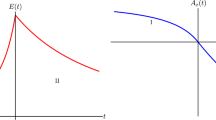Abstract
It is shown that entropy increase in thermodynamic systems can plausibly be accounted for by the random action of vacuum radiation. A recent calculation by Rueda using stochastic electrodynamics (SED) shows that vacuum radiation causes a particle to undergo a rapid Brownian motion about its average dynamical trajectory. It is shown that the magnitude of spatial drift calculated by Rueda can also be predicted by assuming that the average magnitudes of random shifts in position and momentum of a particle correspond to the lower limits of the uncertainty relation. The latter analysis yields a plausible expression for the shift in momentum caused by vacuum radiation. It is shown that when the latter shift in momentum is magnified in particle interactions, the fractional change in each momentum component is on the order of unity within a few collision times, for gases and (plausibly) for denser systems over a very broad range of physical conditions. So any system of particles in this broad range of conditions would move to maximum entropy, subject to its thermodynamic constraints, within a few collision times. It is shown that the spatial drift caused by vacuum radiation, as predicted by the above SED calculation, can be macroscopic in some circumstances, and an experimental test of this effect is proposed. Consistency of the above results with quantum mechanics is discussed, and it is shown that the diffusion constant associated with the above Brownian drift is the same as that used in stochastic interpretations of the Schrödinger equation.
Similar content being viewed by others
REFERENCES
H.-D. Zeh, The Physical Basis of the Direction of Time (Springer, New York, 1989).
P. C. W. Davies, The Physics of Time Asymmetry (University of California, Berkeley, 1974).
I. Prigogine, From Being to Becoming (Freeman, New York, 1980).
A. Rueda, Found. Phys. Lett. 6(1), 75 (1993).
A. Rueda, Found. Phys. Lett. 6(2), 139 (1993).
L. F. Abbott and M. B. Wise, Am. J. Phys. 49(1), 37 (1981).
M. Jammer, The Philosophy of Quantum Mechanics (Wiley, New York, 1974).
H. Goldstein, Classical Mechanics, 2nd edn. (Addison-Wesley, Reading, Massachusetts, 1980), §§ 2-1, 8-1, 8-6.
H. Haken, Synergetics (Springer, New York, 1983).
E. Borel, Le Hasard (Alcan, Paris, 1924).
K. Huang, Statistical Mechanics (Wiley, New York, 1963).
D. Sornette, Eur. J. Phys. 11, 334 (1990).
L. de la Peña and A. M. Cetto, The Quantum Dice: An Introduction to Stochastic Electrodynamics (Kluwer, Dordrecht, 1996).
R. P. Feynman, Statistical Mechanics (Addison-Wesley, Reading, Massachusetts, 1972).
E. Santos, Phys. Lett. A 188, 198 (1994).
W. G. Unruh and W. H. Zurek, Phys. Rev. D 40(4), 1071 (1989); B. L. Hu, J. P. Paz, and Y. Zhang, Phys. Rev. D 45(8), 2843 (1992).
W. H. Zurek and J. P. Paz, Phys. Rev. Lett. 72(16), 2508 (1994).
H. E. Puthoff, Phys. Rev. A 40(9), 4857 (1989); 44(5), 3385 (1991).
H. Everett, III, Rev. Mod. Phys. 29, 454 (1957). D. Bohm and B. J. Hiley, The Undivided Universe(Routledge, New York, 1993). T. Etter, Int. J. Gen. Sys. (1998, in press). Decoherence is sometimes also proposed as an alternative to the collapse hypothesis, within the many-worlds interpretation of Everett; see W. H. Zurek, Phys. Today 44(10), 36 (1991).
C. H. Bennett, Int. J. Theor. Phys. 21, 905 (1982); Sci. Am. (Nov.), 108 (1987).
I. Prigogine, Z. Naturforsch. 52a, 37 (1997).
T. Petrosky and M. Rosenberg, Found. Phys. 27(2), 239 (1997).
In some cases, such as the example herein of a system with an unstable state, entropy increase could ultimately be associated with the vacuum field, because the latter is the cause of “spontaneous” decay of an unstable state ( see P. W. Milonni, The Quantum acuum (Academic Press, New York, 1994) ).
J. von Neumann, Mathematical Foundations of Quantum Mechanics, translated by R. T. Beyer (Princeton University, Princeton, 1955, original work published 1932).
S. Kochen and E. P. Specker, J. Math. Mech. 17, 59 (1967).
N. D. Mermin, Phys. Rev. L ett. 65(27), 3373 (1990).
J. S. Bell, Speakable and Unspeakable in Quantum Mechanics (Cambridge University Press, New York, 1987).
Rights and permissions
About this article
Cite this article
Burns, J.E. Entropy and Vacuum Radiation. Foundations of Physics 28, 1191–1207 (1998). https://doi.org/10.1023/A:1018802204896
Issue Date:
DOI: https://doi.org/10.1023/A:1018802204896




